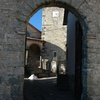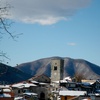Castello di Careggine
Castle of Careggine
The Castle of Careggine, located at 890 metres above sea level at the confluence of the slopes of Mount Torre and Mount Castellina, controlled the route that came from the valley bottom up to Isola Santa and from there on to Versilia.
The village revolves around the old church of Saint Peter and the bell-tower, most likely the keep of the original castle.
The Church of Saint Peter is mentioned from the year 845 in scrolls kept in the Archives of the Bishopric of Lucca, but the title of parish was assigned only in 995. Of the Romanesque church, probably with an apse nave, only a few traces remain, detectable mainly in the right-hand perimeter within which can be recognized a particular relief that likely came from a previous place of worship. An 18th century porch with sandstone columns that support the vaults precedes the façade. Inside there are works of great artistic value such as the stone altars and a statue of St. Anthony of 1563 attributed to Vincenzo Civitali.
No trace remains of the medieval walls, most likely embedded in buildings constructed later. The only recognizable element is the gateway to the village consisting of a simple round arch, dating approximately from the 13th century.
Historical notes
The first mention of the village of Careggine dates from 720 and concerns the foundation of the local church of St. Peter built by Petrualdo “in loco Caricini “. From the sources of our knowledge it seems that the village did not suffer major damage during the wars led by Lucca for the conquest of the Garfagnana region and the fortress was among the defences of the territory of Lucca under Paolo Guinigi. After the fall of the Guinigiano government, Careggine put itself under the protection of the Marquis Lionello of Este, thus becoming part of the House of Este.










